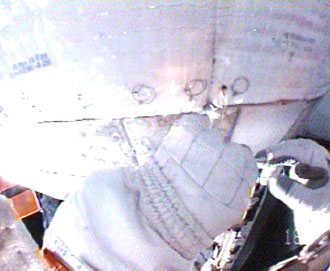The third spacewalk has ended, and NASA hopes that now the shuttle can safely return to Earth * Attempts to solve the computer problem continue

Pictured: John (Danny) Olivas fastens the loose thermal cover to a nearby tile in the left pod of the Space Shuttle Atlantis rocket propulsion system. NASA TV photo
Shortly after the spacewalk began last night, Olivas and Riley went to separate jobs and later helped fold together an old solar collector. In total, the spacewalk lasted longer than planned and lasted seven hours and 58 minutes. The sale ended yesterday at 21:22 US time (04:22 Saturday our time).
As mentioned, Olivas completed the repair work on the heat shield that came out of place in the space shuttle Atlantis. While attached to the shuttle's robotic arm, Olivas clamped the cover in place using a medical stapler. This action is intended to ensure its suitability for its place in the left pod of the rocket propulsion system of the space shuttle Alantis used for maneuvers in space. Riley moved to work outside the International Space Station where he installed a hatch to remove hydrogen from the oxygen production system (as we know on the station oxygen is produced by breaking down water molecules into their components hydrogen and oxygen) from the Destiny laboratory on the station.
Later, the two teamed up and climbed to the top of the P6 component to help fold the solar collector, in preparation for moving the component itself to the edge of the station instead of above it, an operation that will be done on one of the next shuttle flights.
On Sunday, astronaut Sointa Williams will break the record for a stay in space for an American woman. On Sunday at 01:47 a.m. Williams will cross the record of 188 days and 4 hours set by Shannon Lucid in 1996 on the Russian space station Mir.
Efforts to repair the navigation computers are ongoing
Yesterday, space station crew members were able to restore electrical power to two channels on the Russian main computer and two channels on the computer terminal by using a jumper cable that bypasses the broken secondary power switch. The current plan talks about running the computers during the night for the purpose of analyzing the data on Saturday morning (today). Earlier, the space station project manager on behalf of NASA, Mike Superdini, said that flight controllers and engineers from both countries are focusing on efforts to return to use all computer options to maintain altitude control until the problem is resolved.
"I think we're in a good position," Superdini said. "We have many options to fix these systems. We have talented teams of people who examine the height control problem." Concluded. The navigation computers provide backup for the height control system and the route adjustment. Currently, the station's torque gyroscopes handle altitude control and the shuttle Atlantis propulsion system serves as a backup.
